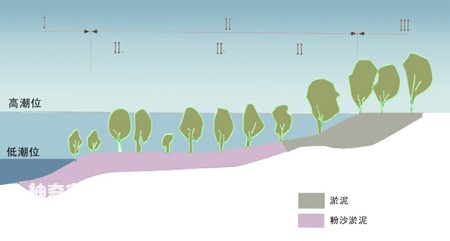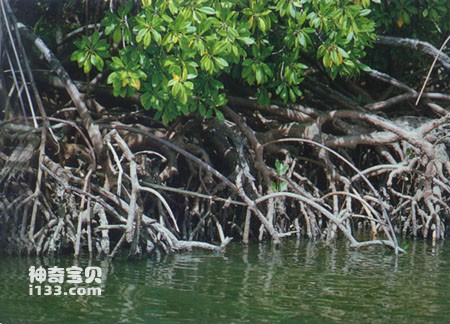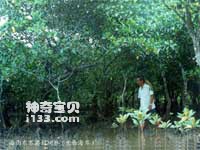Mangrove is a forest that grows in seawater. It is a unique forest vegetation growing in tropical and subtropical coasts and intertidal zones of estuaries. Their root systems are very developed, and they stand intertwined in the tidal flats. They have leathery green leaves that are shiny. Like lotus, they emerge from the mud but remain unstained. At high tide, they are submerged by the sea water, or just reveal their green crowns, as if holding up a green umbrella on the sea. When the tide recedes, it becomes a lush forest.

Schematic diagram of mangrove coast profile
Mangrove coasts are mainly distributed in tropical areas. The east and west coasts of South America, the West Indies, and the west coast of Africa are the main areas where mangroves grow in the Western Hemisphere. In the east, the central distribution areas are Sumatra in Indonesia and the west coast of the Malay Peninsula. Mangroves grow along the Bay of Bengal - India - Sri Lanka - the Arabian Peninsula and the eastern coast of Africa. Mangroves are also widely distributed along the coast of Australia. It is also distributed from Indonesia, the Philippines, and the Indo-China Peninsula to the coasts of Guangdong, Hainan, Taiwan, and Fujian in my country. Due to the influence of the warm Kuroshio Current, mangrove coasts are distributed all the way to Kyushu, Japan.

Mangroves widely distributed in Qinglan Bay, Hainan
my country’s mangrove coast is the most developed in Hainan Province, with many types and a wide area. There are more than 10 species of mangrove plants, including shrubs and trees. Because the bark and wood are reddish-brown, they are called mangroves or mangroves. The leaves of mangroves are not red, but green. The leafy mangroves form a green barrier on the coast. Mangroves develop on tidal flats. There are few other plants here, only mangroves resist wind and waves, forming a unique mangrove coast.

Dense mangroves
Mangrove has the physiological characteristics of high osmotic pressure. Due to high osmotic pressure, mangroves can absorb water and nutrients from swamp saline soil, which is an important condition for mangrove plants to take root and grow in tidal flat saline soil. The root system of mangroves is divided into pillar roots, plate roots and respiratory roots. A mangrove tree can have more than 30 supporting roots. These pillar roots are like the most stable tripod structure supporting objects. They support the main trunk from different directions, making the mangrove unbreakable by wind and waves. Such mangroves play an important role in protecting coastal stability. For example, the severe storm that occurred in Florida in 1960 destroyed thousands of mangroves along the coast, but very few were uprooted. The main damage is from the bark being blown or stripped by cyclone action.

Mangrove plants have extremely developed root systems and grow very quickly.
The respiratory roots of mangrove plants, as the name suggests, play a role in respiration. In a swampy environment, the soil is extremely deficient in air. In order to adapt to this anoxic environment, mangrove plants have extremely developed respiratory roots. The respiratory root is either rod-shaped or genu-shaped. Some are slender, with a diameter of only 0.5 cm, and some are thick, with a diameter of 10-20 cm. Mangrove plant plate roots develop from respiratory roots. Platy roots are beneficial to the respiration and support of mangrove plants. The special function of the mangrove root system allows it to grow even when it is submerged by water at high tide. Mangrove plants are astonishing to see with such a complex and tight structure adapted to the environment in which they grow.

Viviparity of mangrove plants. The fruits of some mangrove plants remain on the mother tree after they mature, and the seeds germinate inside the fruits on the mother tree.
The most interesting thing is the "viviparous" phenomenon of mangrove plant reproduction. The seeds of the mangrove plant mature and germinate on the mother tree. When the seedlings mature, they fall away from the mother tree due to gravity and are inserted into the soil. This "viviparous" phenomenon is rare in the plant world. What makes people even more surprised is that when the seedlings fall into the mud, they can take root and grow in the mud within a few hours. Sometimes the seedlings that fell from the mother tree can grow roots and penetrate into the soil while lying flat on the soil. When the seedlings fall into the water, they drift with the currents. Sometimes it floats in the sea for months or even a year without finding the soil it needs to grow. However, once it encounters suitable soil conditions, it immediately takes root and grows. Although the mangrove grows in water, it is a plant that is not afraid of waterlogging. However, its leathery leaves can reflect light, and the stomata on the leaf surface are sunken and hairy, which can reduce evaporation at high temperatures and have a drought-tolerant ecology. The salt glands on its leaves remove salt from sea water. In addition to fetal germination, mangrove plants also have the ability to reproduce asexually, that is, to sprout. After they are cut down, new plants sprout on the basal stems soon after.
animal tags:
We created this article in conjunction with AI technology, then made sure it was fact-checked and edited by a Animals Top editor.